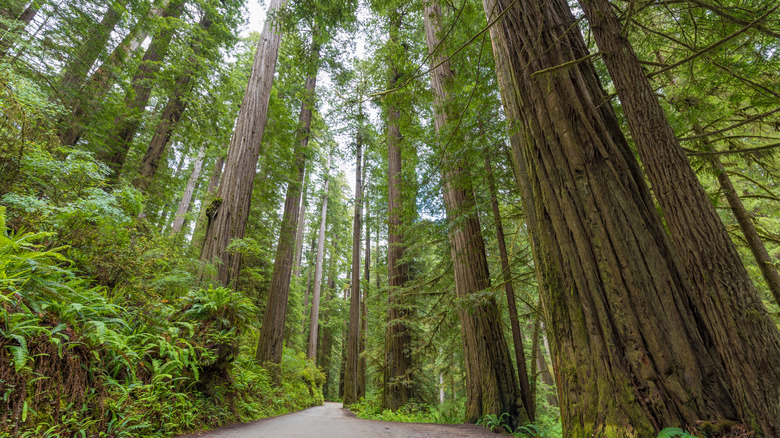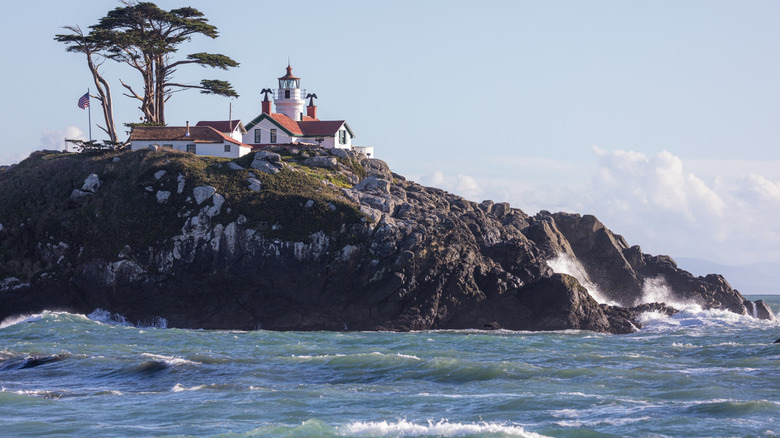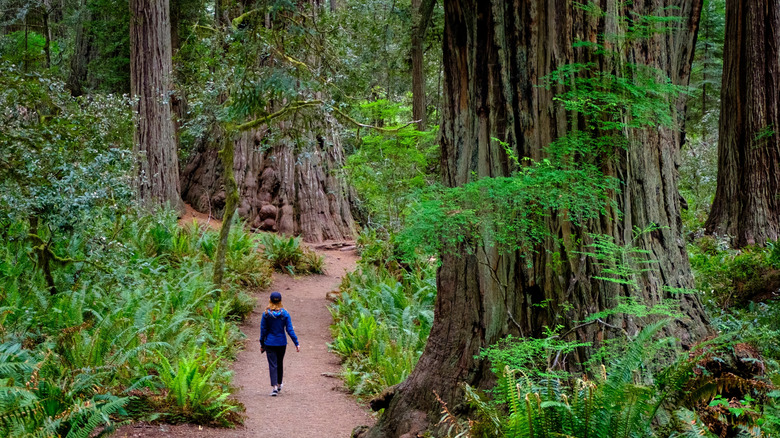This Coastal California City Is Home To Scenic Beaches, Parks, & Towering Redwoods
Crescent City, California, is one of those unforgettable stopovers that make the drive worth it when you're on a road trip in America. A historic lighthouse, breathtaking beach overlooks, towering coastal redwoods, and a state park on the "Star Wars" movie map are all within reach. When I passed through Crescent City (bedding down at a local inn, of which there are many), I was on my way from Portland, Oregon, to San Francisco. It's about an hour's drive from the Welcome to California sign to the sight of the Battery Point Lighthouse, perched atop a small island off the Pacific Coast. As the Crescent City motto says, this is "where the redwoods meet the sea."
The drive takes longer when you pull over for pics along the scenic Redwood Highway (U.S. 199). This highway crosses the state line and winds through Jedediah Smith Redwoods State Park, which is part of the Redwood National and State Parks complex. Veer off the main highway, and you can drive across a wooden covered bridge, down a former stagecoach road (the unpaved Howland Hill Road), to a parking lot at the Stout Grove trailhead.
Ferns and massive tree trunks flank the road, and its single dirt lane is too narrow for anything but cars or vans (no RVs, trucks, or trailers). Yet it leads to a majestic grove of 300-foot-tall trees on the edge of Jedediah Smith Redwoods State Park. On Tripadvisor, the park and its points of interest, including Stout Grove and Howland Hill Road, rank among Crescent City's top attractions, based on traveler favorites. A newer draw for hikers is the nearby Grove of Titans Trail, where a protective boardwalk completed in 2022 links to a once-hidden spot with some of the world's biggest, oldest redwoods.
Explore the Crescent City coastline
The Battery Point Lighthouse is another one of Crescent City's most popular attractions, and this is one where getting there is half the adventure. Only at low tide can you access the lighthouse by crossing the isthmus that connects it to the mainland. When the water rolls in again at high tide, it submerges the land bridge, leaving the island cut off. The lighthouse itself — one of the first on California's coast — began operating with oil lamps in 1856, and it's now on the National Register of Historic Places. Inside is a museum of maritime artifacts and a spiral staircase you can ascend to reach the lookout tower and survey the rocky coastline.
Crescent City takes its name from a beach to the south of its harbor, which curves along the coastline like a crescent moon. You'll see South Beach as you head out of town on the Pacific Coast Highway (U.S. 101). Hang a right onto Enderts Beach Road, and you'll pass Crescent Beach before you hit an overlook with a sweeping view of waves lapping the shore. Those waves can be dangerous after an earthquake, and in fact, Crescent City has been called the tsunami capital of the continental United States.
Tsunami murals and mosaics on buildings and in places like Beachfront Park (which doubles as a sea wall) serve as a reminder of previous disasters and the city's resilience. The half-mile "tsunami walking tour" also connects visitors to nine kiosks downtown, where they can learn about local history and the unique geographic conditions that have made Crescent City so susceptible to devastating waves. In 1964, the worst tsunami ever recorded on the West Coast happened here. In 2011, the city even suffered tsunami damage from a quake as far away as Japan.
See the place where 'Return of the Jedi' was filmed
The deeper you go into Crescent City, the more you forget you're on the coast, or even on Planet Earth. It turns out the Imperial Sand Dunes aren't the only place in California where you can step onto the "Star Wars" set. Filmed in secret under the code name "Blue Harvest," the 1983 sequel "Return of the Jedi" has a fuzzy history among the state's redwoods. It's not always clear which forests were true filming locations, and which are simply associated with "Jedi" through local legend. The movie's original press kit, however, states that Crescent City was "chosen to represent ... the forested moon Endor," home of the furry Ewoks.
You can see the city's name on old location call sheets for "Return of the Jedi," too. In interviews, producer Howard Kazanjian and unit production manager Miki Herman continue to cite Crescent City as a filming site. On its "Map of the Movies," the Humboldt-Del Norte Film Commission shows Jedediah Smith Redwoods State Park as one shooting location, with another being on private property. According to SFGate, the filming was mostly done on that private land near U.S. Highway 101. Unfortunately, a logging company cut down the trees there after production wrapped.
You can see what's left of Endor along the highway and in Jedediah Smith Redwoods State Park. The Film Commission's representatives, its movie map, park rangers, and a visitor center plaque all indicate the movie's speeder bike chase was filmed downstate. Head to Cheatham Grove in Grizzly Creek, another one of California most underrated state parks. For its part, Crescent City welcomes costumed fans to the Forest Moon Festival every May. Combine it with a trip to this massive "Star Wars" museum, and you'll be in Ewok heaven.


